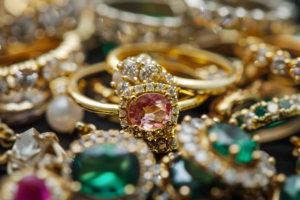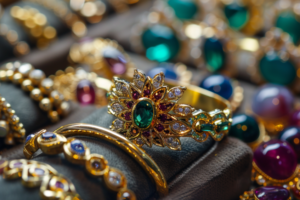Jewellery has long been a significant aspect of human culture, serving as adornment and reflecting social status, artistry, and emotion. Exploring different jewellery designs leads us through a fascinating journey that encompasses history, cultural influences, and contemporary trends. This article delves into the multifaceted world of jewellery design, providing insights into its evolution, categories, materials, technological impacts, and promising future.

Understanding the Art of Jewellery Design
The art of jewellery design is a remarkable blend of creativity, function, and cultural significance. Tracing back to ancient civilisations, jewellery has always been more than mere decoration; it often served as an amulet or status symbol. The materials used varied greatly depending on the region, availability, and cultural preferences, from natural materials like shells and wood to precious metals and gems.
Historically, jewellery design has evolved significantly, reflecting broader social movements and artistic innovations. As artisans gained access to new techniques and tools, they experimented with form, colour, and texture, leading to increasingly intricate and expressive gold jewellery designs in 2024. Today, you can buy gold jewellery showcasing unique designs, including handcrafted and customised ones. Additionally, the latest jewellery trends highlight affordable gold jewellery options and vintage gold jewellery styles, ensuring there is fashion jewellery for every occasion. The diversity in gold jewellery collections inspires collectors and casual buyers alike.
The Role of Culture in Shaping Jewellery Design
Cultural influences are a pivotal factor in jewellery design, informing the styles and meanings embedded within each piece. For example, Indian jewellery is rich in symbolism, often associated with auspicious occasions and rituals. Traditional pieces like the mangalsutra or kangan hold deep cultural significance and are integral to wedding ceremonies.
Similarly, African jewellery often reflects community status, heritage, and artistry. Beaded necklaces or earrings might show affiliation to a tribe or convey messages about the wearer's identity. In contrast, contemporary designs often draw inspiration from diverse cultural motifs, blending traditional techniques with modern aesthetics, which leads to truly unique pieces.

Diving Into Different Jewellery Design Categories
Jewellery can broadly be categorised into traditional, contemporary, artisanal, or bespoke designs, each offering distinct characteristics and appeals. Understanding these categories allows consumers to appreciate the variety and artistry of jewellery-making, including gold jewellery collections featuring unique designs. There is something for everyone, from handcrafted gold jewellery to customised jewellery designs. Additionally, exploring vintage gold jewellery styles and the latest trends can enhance your choices when buying gold jewellery. Whether you seek affordable gold or fashion jewellery for every occasion, knowing the different design categories enriches the overall experience.
Traditional Jewellery Designs
Traditional jewellery designs often evoke nostalgia and heirloom value, rooted in cultural practices and familial heritage. These designs typically showcase techniques passed down through generations, featuring distinctive motifs and craftsmanship that resonate with specific customs. Common examples include the intricate gold jewellery from South Asia and the classic pearl pieces from the West.
Such designs often feature traditional gemstones and materials that vary based on geographical regions. For instance, turquoise is frequently found in Native American jewellery, while jade is treasured in East Asian cultures. The enduring nature of these pieces ensures they remain timeless treasures, often handed down as family legacies.
Contemporary Jewellery Designs
Contemporary jewellery design reflects current trends and styles, often characterised by innovative techniques and materials. Modern designers frequently experiment with abstract forms, asymmetry, and unexpected combinations of materials, such as combining metal with wood or stone. The focus often lies on individual expression and wearing art rather than mere adornment. Furthermore, contemporary jewellery may incorporate storytelling elements, where each design narrates a unique personal or emotional journey. This genre encourages wearers to explore new ideas of beauty while fostering a deeper understanding of art in personal expression.
Artisanal and Bespoke Jewellery Designs
Artisanal and bespoke jewellery offers a personalised touch that mass-produced items cannot replicate. These pieces are often handcrafted by skilled artisans who infuse their techniques, culture, and creativity into each work. Clients can collaborate with artisans to create unique jewellery that reflects their personality or commemorates special occasions. This category often emphasises sustainable practices, using ethically sourced materials and environmentally friendly methods. Consequently, buyers increasingly seek out these unique pieces, appreciating the story and craftsmanship behind them.

The Materials That Make a Difference
The choice of materials in jewellery design significantly influences the pieces' overall aesthetics and emotional resonance. From precious metals to unusual alternatives, various materials allow for enhanced creativity and personal expression.
Gold and Silver Designs
Gold and silver have long been the staples of jewellery design, valued for their rarity, beauty, and malleability. With its rich yellow hue, gold has become synonymous with luxury and wealth, often adorning high-end pieces. Silver, frequently considered a more affordable yet equally beautiful alternative, carries a distinct elegance that appeals to a wide audience. These metals are traditionally associated with various cultural significances and uses in jewellery, such as wedding bands, religious symbols, and family heirlooms, each resonating with personal stories and customs.
Gemstone-Centred Designs
Gemstones play a crucial role in jewellery design, adding colour, brilliance, and unique patterns to each piece. Diamonds, emeralds, sapphires, and rubies are among the most popular choices, each carrying its symbolism and desirability. In recent years, there has been a growing trend towards alternative gemstones, such as lab-created stones or lesser-known gems like tourmaline or opal, allowing for more diverse expression in designs. Fusing these stones with traditional or contemporary design elements results in striking pieces that stand out for their individuality.
Alternative Materials in Jewellery Design
Beyond precious metals and gemstones, artisans are increasingly exploring alternative materials in jewellery design. Materials such as resin, plastics, leather, and wood provide new avenues for creativity and expression. These materials often evoke a casual or avant-garde feel, appealing to diverse tastes. The rise of sustainable consciousness also drives this trend, with artisans seeking eco-friendly materials that reduce environmental impact. By incorporating recycled materials or sustainably sourced options, designers can create pieces that not only please aesthetically but also resonate with eco-friendly values.

The Impact of Technology on Jewellery Design
The influence of technology on jewellery design is both profound and transformative. It has reshaped traditional practices while opening up new methodologies and possibilities for designers, allowing them to create unique jewellery designs and customised jewellery designs with greater precision. Technology integration has also facilitated the emergence of handcrafted gold jewellery and vintage gold jewellery styles that blend modern techniques with classic aesthetics. As a result, consumers can now explore gold jewellery collections that reflect the latest jewellery trends and offer affordable gold jewellery options. This technological advancement ensures that there is fashion jewellery for every occasion, making it easier than ever to buy gold jewellery that suits individual tastes and preferences.
Computer-Aided Design in Jewellery
Computer-aided design (CAD) has revolutionised the jewellery design process, allowing designers to create intricate patterns and prototypes precisely. CAD enables artists to visualise their concepts in 3D, ensuring accuracy before production begins. This technology saves time and resources and enhances collaboration among designers and clients. Visualising pieces digitally allows for tailored modifications, ensuring the final product aligns perfectly with the client's vision and expectations.
3D Printing and Its Influence on Design
3D printing technology has emerged as a game changer in the jewellery industry. It allows for rapid prototyping and reduced production costs. Artists can use this technology to produce intricate designs that would have been nearly impossible to create by hand. This innovation also encourages experimentation and creativity, enabling designers to develop unconventional forms and complex details that are light and airy yet striking. As 3D printing becomes more accessible, it will likely spur innovation in jewellery design, catering to the growing demand for unique, custom-made pieces.

The Future of Jewellery Design
Looking ahead, the future of jewellery design promises to be as exciting and diverse as its rich history. With an emphasis on sustainability, inclusivity, and technology, today's designers are at the forefront of shaping tomorrow's narratives in the jewellery landscape.
Sustainable and Ethical Designs
The demand for sustainable and ethical jewellery has grown significantly, reflecting a broader societal shift towards responsible consumption. Designers are now focusing on using recycled materials, ethically sourced gemstones, and environmentally friendly production methods. This shift appeals to eco-conscious consumers and fosters community as artisans and brands commit to transparent practices. As sustainability becomes more embedded in the jewellery sector, designs will increasingly align with consumers' values and lifestyles.
The Rise of Unisex Jewellery Designs
Unisex jewellery designs are gaining traction, breaking traditional gendered barriers in adornment. This evolution reflects a more inclusive approach, allowing individuals to express their identities without conventional constraints. Unisex designs often feature minimalist aesthetics and adaptable styles that appeal to a broad audience. This movement encourages diversity and personal expression, with jewellery becoming a versatile medium for showcasing individuality, regardless of gender.
Predicted Trends in Jewellery Design
As we move forward, several predicted trends are shaping the future of jewellery design. Expect more bold statements in colour, eclectic combinations, and innovative uses of alternative materials. Furthermore, integrating technology will inspire designers to push boundaries, creating new forms and functions, including unique and customised jewellery designs.
Moreover, personalised and story-driven pieces will flourish as consumers seek gold jewellery collections that resonate emotionally and aesthetically. This trend aligns with the growing interest in handcrafted gold jewellery and vintage gold jewellery styles. Ultimately, the evolution of jewellery design will remain a captivating blend of artistry, culture, and innovation, ensuring its enduring significance in our lives, especially as more people look to buy gold jewellery that reflects the latest jewellery trends and offers affordable gold jewellery options. With these developments, there will be fashion jewellery for every occasion, appealing to diverse tastes.





Article
Exploring the Various Types of Jewellery Designs
The art of jewellery design is a captivating journey through time and culture. From ancient civilisations to modern innovations, jewellery has always symbolised beauty, status, and personal expression. Explore the diverse materials, techniques, and styles that make jewellery a timeless art form.